A Russian squad tries to reinforce a front-line position. “According to reports, they were sent in on noisy, underpowered bikes without reconnaissance or suppressing Ukrainian positions two kilometers away,” WarTranslated explains. “As soon as the Ukrainians spotted them, they opened fire with an automatic grenade launcher and a mortar, then deployed kamikaze drones.”
At least two of them explode near the Russian soldier wearing the GoPro-style helmet camera. The first drone detonates nearly under the front wheel of his motorcycle as he tries to move out. Wounded, he stumbles into the woods, where another drone explodes near enough to concuss him.
Confusion reigns. We witness ‘battlefield friction,’ the phenomenon wherein the simplest tasks become difficult to execute and commands have to be repeated (“Start it, faster!”). The Russians appear to have no map or compass to guide them. The camera-wearer communicates with someone on a radio and asks hopefully about the way back. All he recieves are instructions to keep moving in a general direction from the road. Who even knows if any of these Russians are still alive.
Drone war reaches far beyond the line of contact. The ‘gray zone’ is under observation at all times. Neither side can assemble force and get it very far without a swarm of drones closing it on them before they arrive at the objective. According to the British International Institute for Strategic Studies, Russia lost 5,100 tanks and armored vehicles in 2024 — almost twice as many as the previous year — and will run out of them starting in 2026. Most of these losses were due to drones, either through observation or direct targeting.
Furthermore, because Ukrainian tactics have focused on the weaknesses of Russian logistics, they have destroyed about as many trucks and other cargo-carrying vehicles as tanks since 2022. As seen in the video below, most Russian vehicles are now light civilian models. Some of the targeted trucks and cars and vans in this video have not even received a spray of tactical paint. Lately, civilian vehicles have accounted for the most observed Russian daily losses.
Another thing to note in this video is ground fire. Russians are shooting at the drones attacking them. Believe it or not, this sometimes works. In fact, shotguns are the hot new battlefield firearm these days.
The first-person viewer (FPV) drone operators are clearly uninterested in the Russians, just their vehicles. Many of these images have low battery or “land now” warnings because the operator has let it sit in a field for hours, waiting for the Mavic drone hovering overhead to spot movement. The drone war absolutely devastates logistics.
The war in Ukraine has seen the advent of ground drones in combat. A few weeks ago, a platoon of Ukrainians attempted the first all-drone assault on a Russian position near Lyptsi in Kharkiv Oblast. A combination of FPV drones and remotely controlled machine guns on wheels reportedly forced the Russians out of their position, which Ukrainian infantry then took over. But the big news about ground drones is the dangerous jobs they do in place of squishy humans.
For example, here is a short clip of an unmanned ground vehicle (UGV) laying anti-tank mines in no man’s land. There are also demining UGVs. Other UGVs can carry cargo out to a forward position and extract a casualty back to safety without risking a human driver. Put another way, one of the primary ways of adapting to the drone battlefield is … more drones! Note that in 2022, Russia was known for cutting-edge UGV development, but that is not true anymore.
Last October, Russians in Kursk Oblast began to suffer horrific accidents while driving at night. They would be humming down the highway at 100 miles an hour (161 km) to avoid drone attacks, when suddenly, concrete ‘dragon’s teeth’ appeared in the middle of the roadway. (Real dragon’s teeth are fixed in the ground.) Note that there appear to be some sort of harnesses attached to them.
As one would expect, these accidents left Russians dead or injured. In many cases, these vehicles were either owned by a unit, or else by soldiers in the unit who were using them for military business. They had to. After all, Russia is running short of vehicles.
Here is a video released by the Ukrainians. It shows a very large ‘Baba Yaga’ drone, an eight-armed monster with double blades — sixteen rotors — lifting off with a concrete traffic pyramid and carrying it off to lay on a Kursk highway. Not only is this inventive, it demonstrates the utility of air cargo using drones to reach isolated points and resupply troops under fire. Also, imagine this drone delivering building materials to the 20th floor of a skyscraper under construction, because that is our likely future.
Finally, here is a collection of Russian reconnaissance drones being intercepted by Ukrainian FPVs. Two things are noteworthy. First, every intercept uses the same tactic of approaching from six o’clock high to ram the target from above and behind. Historically, this is both the most successful aerial ramming tactic and the most suicidal for the pilot. Because Ukrainians are already flying suicide drones, there is no downside in the one-for-one exchange, however.
Ukraine is delivering 200,000 drones to the front line every month. While Russians are doing the same things with drones, Telegram milbloggers have been lamenting the Ukrainian advantage in numbers. As seen in these videos, drones are replacing humans in the most dangerous battlefield roles while contesting the ‘gray zone.’ A military revolution is taking place. All of the old field manuals will have to be rewritten.
Russian Army Resorts To Donkey Logistics
Your mileage may vary according to size and temperament, but as a rule of thumb, the average donkey can carry about 110 lbs (50 kg), a little more than the combat load of a modern soldier. In a self-sustaining ‘donkey park,’ one animal can carry enough bundled straw or hay for four donkeys for four days. A donkey-dependent logistical chain thus begins w…











